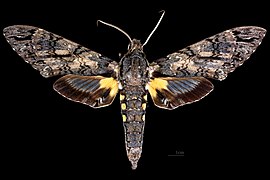
Manduca rustica, the rustic sphinx, is a moth of the family Sphingidae. The species was first described by Johan Christian Fabricius in 1775.
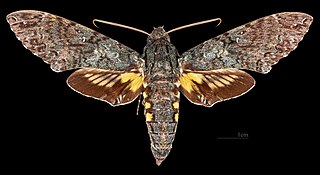
Amphonyx duponchel, or Duponchel's sphinx, is a moth of the family Sphingidae. The species was first described by Felipe Poey in 1832.

Cocytius lucifer is a moth of the family Sphingidae first described by Walter Rothschild and Karl Jordan in 1903.

Manduca muscosa, the muscosa sphinx, is a moth of the family Sphingidae.

Manduca occulta, the occult sphinx, is a moth of the family Sphingidae.

Smerinthus jamaicensis, the twin-spotted sphinx, is a moth of the family Sphingidae. The species was first described by Dru Drury in 1773.
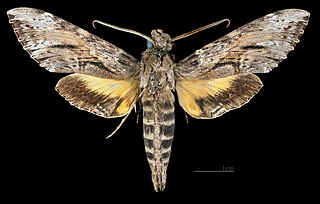
Isognathus rimosa, the rimosus sphinx, is a moth of the family Sphingidae. The species was first described by Augustus Radcliffe Grote in 1865.

Pachylia ficus, known as the fig sphinx, is a moth of the family Sphingidae. It lives from the northern tip of South America in Uruguay through Central America to the southern tip of the United States straying into Arizona and Texas.
Pachysphinx modesta, the modest sphinx or poplar sphinx, is a moth of the family Sphingidae. The species was first described by Thaddeus William Harris in 1839.

Perigonia lusca, the half-blind sphinx or coffee sphinx, is a moth of the family Sphingidae. It was first described by Johan Christian Fabricius in 1777.

Aellopos clavipes, also known as the clavipes sphinx, is a moth of the family Sphingidae.
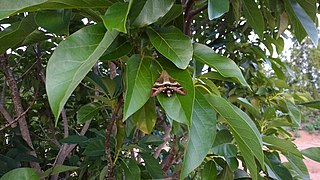
Aellopos fadus, the Fadus sphinx, is a moth of the family Sphingidae. The species was first described by Pieter Cramer in 1776.

Aellopos titan, the Titan sphinx, is a moth of the family Sphingidae. The species was first described by Pieter Cramer in 1777.

Eumorpha satellitia, the satellite sphinx, is a moth of the family Sphingidae. The family was first described by Carl Linnaeus in 1771. It lives from Brazil and northern Argentina north through Central America, Mexico, and the West Indies to south Texas and southern Arizona.

Eumorpha vitis, known as the vine sphinx, is a moth of the family Sphingidae.

Deidamia inscriptum, the lettered sphinx, is a species of moth of the family Sphingidae. It is the only member of the genus Deidamia. The species was first described by Thaddeus William Harris in 1839 and the genus was erected by James Brackenridge Clemens in 1859.

Aellopos tantalus, known as the Tantalus sphinx, is a moth of the family Sphingidae. It is found in Florida, the Antilles, from Mexico to Venezuela, Colombia, Ecuador, Suriname, and in the Amazon basin.

Sphinx kalmiae, the laurel sphinx, is a moth of the family Sphingidae.
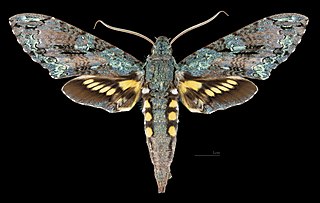
Pseudococytius is a genus of hawkmoths. The single species, Pseudococytius beelzebuth was placed in Cocytius for a long time.

Callionima parce, the parce sphinx moth, is a species of moth in the family Sphingidae.It was originally described by Johan Christian Fabricius in 1775.

